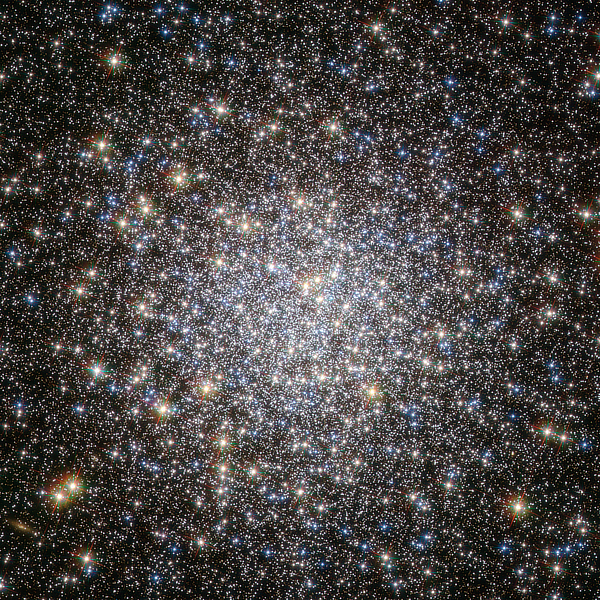Messier 5 in Serpens Caput
May 2024 - Nebula and Cluster of the Month
May is another very poor month for nebulae and clusters. Galaxies still reign supreme in the target lists of northern hemisphere deep-sky observers.
This month we’re going to have a quick look at one of the few objects mentioned in these articles not discovered by William Herschel. This object was discovered in 1702 by Gottfried Kirch (1639—1710). After a varied and not always successful series of career choices, Kirch became director of the Berlin Observatory. His other discoveries include Messier 11 (an open cluster in Scutum) and the Mira-type variable star, χ Cygni. He has a crater named after him on the Moon and asteroid 6841 Gottfriedkirch is named in his honour.
Charles Messier observed this globular cluster, which was to be catalogued by him as Messier 5, on 23 May 1764 and described it as A fine nebula which I am sure contains no star. Round; seen well in a good sky in a telescope of 1-foot (focal length).
Superior telescopes in later years corrected Messier’s impression that the object contained no stars. In May 1791, William Herschel inspected it with his 48” reflector. Although very famous and for many years the largest telescope in the World, the 48” was never very satisfactory. It was very cumbersome to use and the mirror (Herschel made two, only one of which was usable), was less than optimal. Nevertheless, Herschel described seeing about 200 stars involved and stated that ...the middle was so compressed that it is impossible to distinguish its components.
Our own Reverend T W Webb described it as A beautiful assemblage of minute stars, 11—15 mag. Greatly compressed in the centre.

When it was included in the 1888 New General Catalogue, it was given the designation NGC 5904.
M5 lies in the constellation of Serpens Caput, in an area devoid of bright naked-eye stars. It is about 7¾° south-west of 2.6 magnitude α Serpentis, and even less usefully, 29° south-east of Arcturus (α Boötis).
M5 has an apparent diameter of about 20’ (well over half a full moon) and shines at a very respectable magnitude 5.7, making it technically a naked-eye object under good skies. At declination 2°N, however, it never gets more than 37° above the horizon in mid-Britain. It is, however, an easy binocular object.
Over 100 variable stars have been identified within M5, 97 of which are the familiar ‘cluster variables’, RR Lyrae-type variables. RR Lyr stars are similar to Cepheid variables and also act as ‘standard candles’ for distance measurement. The distance derived from these standard candles is 7,500 parsecs or 24,500 light-years.
Studies of the stellar population of M5 have provided some unexpected results. It is often assumed that all the stars in a globular cluster are of the same age; that is, they all formed at the same time. It’s not an unreasonable assumption, given the relative lack of potentially star-forming gas in globular clusters. Studies showed that in fact, M5 hosted not one, but two populations of stars. A more recent study1 has revealed that there are actually three populations. The majority of stars, spread evenly through the cluster, form the first population. The second and third populations are concentrated close to the centre of the cluster and display higher-than-normal abundances of nitrogen.
How did these later populations of stars form? It seems that they may be formed from the gaseous wreckage left by the supernova explosions of the most massive members of the first generation of stars. The stars in M5 are literally recycling themselves.
M5 is a glorious sight in a modest amateur telescope. One feature that stands out is that it is noticeably elliptical – an unusual feature in globular clusters. Stars are scattered across the field like salt on a black cloth. The brightest stars in the cluster are around 12th magnitude. As I have noticed in other bright globular clusters, the individual stars at the centre are lost against the brilliant glow.
If you tire of little fuzzy galaxies this month, give your eyes a treat and seek out this staggeringly beautiful object.
| Object | RA | Dec | Type | Magnitude |
|---|---|---|---|---|
| M 5 | 15h 18m 34s | +02° 04’ 58” | Globular cluster | 5.7 |
References:
- Formation of Multiple Populations of M5 (NGC 5904), Jae-Woo Lee 2021 ApJL 918 L24.
If you'd like to try out the Clear Skies Observing Guides (CSOG), you can download observing guide for the current Cluster of the Month without the need to register. CSOG are not associated with the Webb Deep-Sky Society but the work of Victor van Wulfen.